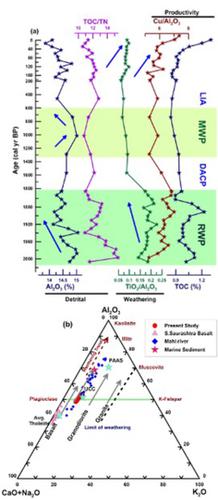当前位置:
X-MOL 学术
›
Geolog. J.
›
论文详情
Our official English website, www.x-mol.net, welcomes your
feedback! (Note: you will need to create a separate account there.)
Hydroclimate variability during the last two millennia from the mudflats of Diu Island, Western India
Geological Journal ( IF 1.4 ) Pub Date : 2021-03-13 , DOI: 10.1002/gj.4116 Upasana S. Banerji 1, 2 , Ravi Bhushan 1 , Kumar Batuk Joshi 2 , Jithu Shaji 2 , A. J. Timothy Jull 3
Geological Journal ( IF 1.4 ) Pub Date : 2021-03-13 , DOI: 10.1002/gj.4116 Upasana S. Banerji 1, 2 , Ravi Bhushan 1 , Kumar Batuk Joshi 2 , Jithu Shaji 2 , A. J. Timothy Jull 3
Affiliation

|
The climate variability over western India has been significantly influenced by the perturbations in the Indian summer monsoon (ISM) and thus, provides a crucial platform to investigate the paleomonsoon variations, weathering intensity, and sediment source. The mudflats of southern Saurashtra, western India are deprived of perennial rivers, but the region receives terrestrial contribution exclusively due to activation of seasonal rivers during the monsoon. In the present study, an attempt has been made to investigate the paleomonsoon and palaeoweathering using various geochemical proxies (detrital, productivity, redox, and weathering) on the mudflat sediment core of southern Saurashtra, western Gujarat. The core is chronologically constrained by 14C, 210Pb, and 137Cs dating techniques. The study suggests ISM strengthening during 2000–1800 cal yr BP with intermittent marginal ISM weakening during 1950–1970 cal yr BP and 1930–1890 cal yr BP associated with the reduced solar irradiance. Further, ISM weakening has been invoked during Dark Age Cold period (1800–1300 cal yr BP) and Little Ice Age (800–200 cal yr BP) interrupted by a marginal ISM strengthening during Medieval Warm period and the last two centuries witness climate warming. Based on historical rainfall data and Al2O3, an intermittent strengthening of ISM during 90–30 cal yr BP has been suggested while a gradual increase in the weathering intensity synchronous to the rise in sea surface temperature (SST) during the last 200 cal yr BP revealed the role of temperature on the intensity of chemical weathering in the study area. In spite of changes in the geochemical proxies as a function of ISM fluctuations, the palaeoweathering intensities has remained nearly consistent wherein the chemical weathering was less operative and accompanied by the deposition of texturally immature sediments. The sediments of Diu mudflat indicate mafic signatures thereby underscoring a major contribution of the Deccan basalts along with other variable sources.
中文翻译:

印度西部 Diu 岛泥滩过去两千年的水文气候变化
印度西部的气候变异受到印度夏季风(ISM)扰动的显着影响,因此为研究古季风变化、风化强度和沉积物来源提供了重要平台。印度西部索拉施特拉南部的泥滩缺乏常年河流,但该地区仅由于季风期间季节性河流的激活而获得陆地贡献。在本研究中,已尝试使用各种地球化学指标(碎屑、生产力、氧化还原和风化)对古吉拉特邦西部索拉施特拉邦南部泥滩沉积物核心进行古季风和古风化作用研究。核心按时间顺序受到14 C、210 Pb 和137Cs约会技术。该研究表明,ISM 在 2000-1800 cal yr BP 期间加强,而在 1950-1970 cal yr BP 和 1930-1890 cal yr BP 期间间歇性边缘 ISM 减弱与太阳辐照度降低有关。此外,在黑暗时代寒冷时期(1800-1300 cal yr BP)和小冰河时代(800-200 cal yr BP)期间,ISM 减弱被中世纪温暖时期的边缘 ISM 加强所打断,最后两个世纪见证了气候变暖. 根据历史降雨数据和 Al 2 O 3,已经提出了在 90-30 cal BP 期间 ISM 的间歇性加强,而在过去 200 cal BP 期间与海面温度 (SST) 上升同步的风化强度逐渐增加揭示了温度对强度的作用研究区的化学风化作用。尽管地球化学指标随 ISM 波动而变化,但古风化强度几乎保持一致,其中化学风化作用较弱,并伴有结构不成熟沉积物的沉积。Diu 泥滩的沉积物表明了基性特征,从而强调了德干玄武岩以及其他可变来源的主要贡献。
更新日期:2021-03-13
中文翻译:

印度西部 Diu 岛泥滩过去两千年的水文气候变化
印度西部的气候变异受到印度夏季风(ISM)扰动的显着影响,因此为研究古季风变化、风化强度和沉积物来源提供了重要平台。印度西部索拉施特拉南部的泥滩缺乏常年河流,但该地区仅由于季风期间季节性河流的激活而获得陆地贡献。在本研究中,已尝试使用各种地球化学指标(碎屑、生产力、氧化还原和风化)对古吉拉特邦西部索拉施特拉邦南部泥滩沉积物核心进行古季风和古风化作用研究。核心按时间顺序受到14 C、210 Pb 和137Cs约会技术。该研究表明,ISM 在 2000-1800 cal yr BP 期间加强,而在 1950-1970 cal yr BP 和 1930-1890 cal yr BP 期间间歇性边缘 ISM 减弱与太阳辐照度降低有关。此外,在黑暗时代寒冷时期(1800-1300 cal yr BP)和小冰河时代(800-200 cal yr BP)期间,ISM 减弱被中世纪温暖时期的边缘 ISM 加强所打断,最后两个世纪见证了气候变暖. 根据历史降雨数据和 Al 2 O 3,已经提出了在 90-30 cal BP 期间 ISM 的间歇性加强,而在过去 200 cal BP 期间与海面温度 (SST) 上升同步的风化强度逐渐增加揭示了温度对强度的作用研究区的化学风化作用。尽管地球化学指标随 ISM 波动而变化,但古风化强度几乎保持一致,其中化学风化作用较弱,并伴有结构不成熟沉积物的沉积。Diu 泥滩的沉积物表明了基性特征,从而强调了德干玄武岩以及其他可变来源的主要贡献。











































 京公网安备 11010802027423号
京公网安备 11010802027423号